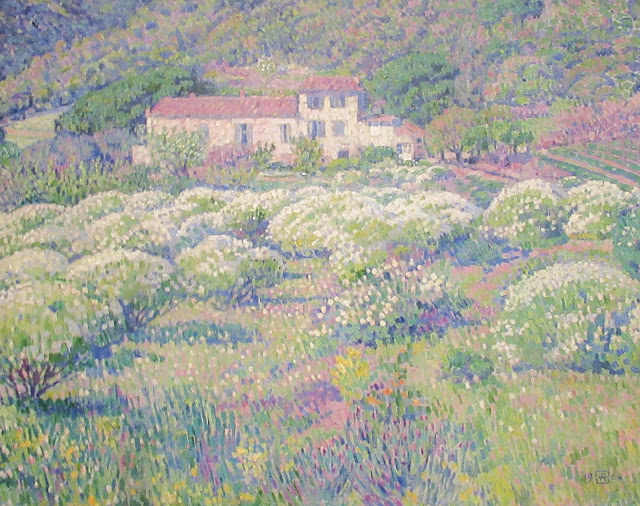Neo-Impressionism in the colours of the Mediterranean at the Goulandris Foundation, Athens.
This is the second post on this exhibition - I have used the same introduction as in post 1 which you can find
Neo-Impressionism, or Divisionism, also called chromoluminarism, is the characteristic style of painting defined by the separation of colours into individual dots or patches that interact optically. This exhibition is dedicated to the Mediterranean years of the Neo-Impressionists. It follows the artistic development of Signac, Cross, Luce and Van Rysselberghe towards a freer and bolder style of painting. The palette of these artists, enamoured of pure colours, continually gains in vigour and vicaciousness. As such, it illustrates in the most elegant way possible the words of authors who had ventured before the painters into this little-frequented Mediterranean coastline: Guy de Maupassant, Stendhal, Theodore de Banville. Initially prized by people suffering from poor mental health, the Mediterranean climate attracts increasingly greater numbers of art lovers who are enticed by a genre of painting that is from that time on solidly rooted in the sensory and the subjective.
Signac and Cross remain faithful to the Neo-Impressionist technique to the end of their days, but Luce and Van Rysselberghe will gradually distance themselves. Newcomers like Matisse, Manguin will experiment with the divided brushstroke quite diligently, with an independent spirit that anticipates the artistic revolutions to come.
On March 29, 1891, Georges Seurat dies unexpectedly at the age of 31. The death of the founder of Neo-Impressionism leaves the other members of the group - in particular, Paul Signac, Henri-Edmond Cross, Maximilien Luce and Theo Van Rysselberghe - at a loss. Many critics and painter friends, including Camille Pissarro, foresee an imminent end to the artistic movement which they misinterpret as nothing more than a transient rebellious offshoot of Impressionism.
However, Seurat's death marks only the closing of the first chapter of Neo-Impressionism. A second chapter will soon unfold, far from Paris, on the shore of the Mediterranean. And, Signac, now the leader of the group, takes it towards new horizons, both geographic and artistic.
2. Liberating Colour.
Under the alternately soothing and fierce Mediterranean sun, Signac, Van Rysselberghe, Cross and Luce intensify their pictorial explorations, as such orientating Neo Impressionism towards a more colourful and contrasting painting. The dot enlarges and, in some cases, becomes a mosaic tessera and moves more freely. Cross and Luce are quick to transpose their advance to the human figure, creating in this way allegorical scenes that soon fascinate many a young artist, Matisse included.
We are indebted to Signac for the most eloquent tributes to the endlessly renewed appeal of the south that will thus become the ideal locale for future avant-garde movements. This same period is also marked by Luce and Van Rysselberghe's gradual distancing from Divisionism.
Paul Signac, Antibes, The Towers, 1911, (oil on canvas)
Henri-Edmond Cross, Saint-Clair Beach, 1901, (oil on canvas)
Cross here connects with the unwavering values of Divisionism: the large touches evoke the mosaic and their ordering, more or less linear, gives the most prominent position to contrasts. The stillness of the sea is only disturbed by two elements: the approaching boat and the six birds swirling around a probable underwater prey, painted in a classical manner. The winter period, and its reduced sunshine, are brilliantly rendered, as is the atmosphere loaded down with humidity, which facilitates the formation of clouds diffracting the dim light of the sun.
Paul Signac, Seashore (Saint-Tropez, The Custom's Path), 1905, (oil on canvas)
3. A dialogue with the Fauves:
Henri Manguin, Jeanne on the Balcony of the Villa Demiere, 1905, (oil on canvas)
Van Rysselberghe gradually distanced himself from division as of 1897. Although he embraced a style that could not be more classical, he did not fail to punctuate some of these works with a fragmented touch, reminiscent of his Neo-Impressionist years. The contrast might no longer be respected, but he achieved a completely comparable luminosity, as illustrated by Anthemis in Bloom. This distancing from the Neo-Impressionists made the critic Louis Vauxcelles say: 'The Midi by Van Rysselberghe belongs to him in his own right. It is neither the poetic Midi of Remoir... nor the rough Midi of Valtat, nor the translucent Midi of Signac, but a Midi of a gentle and noble harmony'.
Paul Signac, Saint-Tropez, The Tartan, 1905, (oil on canvas)
Henri Manguin, Saint-Tropez, Sunset, 1904, (oil on canvas)
Henri-Edmond Cross, Study for the Scarabee, 1905, (oil on canvas)


















No comments:
Post a Comment